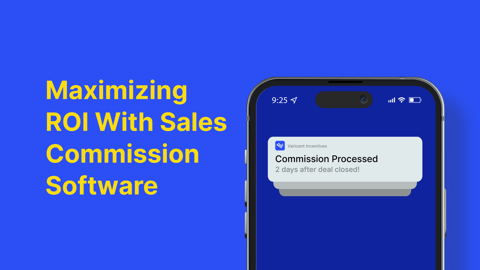If there is one topic guaranteed to generate endless discussions, it’s the vexed topic of commission.
It’s easy to see why. Sellers work long hours to generate the revenues the business needs, and they don’t want their contribution to be undervalued. Equally, sales managers want to set up their sales teams for success, HR managers want to help create commission programs that make the company attractive to candidates, and finance teams want to ensure the business achieves its financial targets.
But like anything, there is a right way to approach this topic. Let’s explore how the right commission model and the right technology can help you grow your business.
The Importance of Sales Commission Models
Let’s start with the basics: People selling products or services have very different jobs than their peers in the marketing, operations, production, or logistics functions.
Sales is about handling rejection and turning that into a positive by building relationships, finding new information about a prospect, or learning more about a particular industry. ‘The harder you work, the luckier you get,’ goes the well-known adage, but that’s not always the case. A salesperson can work 60 hours a week on the wrong opportunities, promoting the wrong product to the wrong prospects. Success isn’t guaranteed.
The goal of a quota model – and the commission model that supports it – is to get salespeople to focus on what matters and not waste time on opportunities that might be interesting but won’t drive the results the business needs.
Commission and quota models help identify who is doing well and who would benefit from additional support, training, or development. However, care needs to be put into designing commission models. They can be precision instruments that drive business growth, but they can equally be blunt instruments that create as many problems as they solve.
How Do Commission Models Work?
At their core, commission models work based on the idea that the more business a salesperson closes, the more they can earn. However, this simple idea can mask complexities that catch out salespeople and their managers.
Different models are better suited to different sales situations. Let’s look at some of the most commonly used models:
1. Straight Commission Models
Here, a salesperson earns a fixed percentage of a transaction’s revenue –say 20%. They can quickly determine what they’re likely to earn when closing a transaction. This model may be combined with a base salary element, or it may pay commission only. It’s easy to manage and is often used when the sales process is simple and quick.
While easy to administer, this model can create incentives for the salesperson to act against the company’s interests, where perhaps they use high pressures sales tactics to close a deal that makes problems for the company long after the salesperson has moved on to other opportunities and likely been paid.
2. Tiered Commission Models
Tiered commission models utilize a range of factors to determine how much commission a salesperson earns on a particular transaction. Tiered models aim to create a ‘precision instrument’ for sales managers to align a salesperson's behavior more closely with the business's needs. In principle, a tiered model will create more value for the company than a less sophisticated commission model.
A tiered commission model can work in several ways. Firstly, it can incorporate a range of variables to fine-tune a commission model, for example, by product line or account type. You can even fine-tune these variables through the sales year so that salespeople are incentivized in a way that supports the business most effectively.
Let’s look at some of these variables in more detail:
Timings
Revenues that close earlier in the year are considered more valuable than those that close at year-end. Money in the bank is far more valuable than any revenue sitting in the sales pipeline. The closed business provides clarity to managers and shareholders alike and brings the year-end target a little bit closer.
Some commission models capture this time value by weighting revenues closed in Q1 and Q2 more heavily than those in Q3 and Q4.
Quota Achievement
Every commission plan is structured around its quota model. Still, you can further utilize the quota achievement model to refine the commission model and provide incentives for salespeople to over-perform.
For example, you might put in a compensation model that pays a higher commission rate above 50% or 75% achievement, with significant commission increases once a salesperson is at 100% quota.
This process needs careful management and clear explanations for salespeople. In this model, two salespeople can be paid differently on an identical transaction, both of equal value to their employer. Without a complete understanding by all concerned, it’s possible for one salesperson to feel aggrieved at the situation, which can impact their focus and result in time spent by a sales operations team explaining the situation. Effort must be put into planning territory and quota models to ensure equal opportunity for all. The idea that some people have been set up for success can be toxic in a sales organization.
New Account vs. Existing Accounts
Another variable businesses often consider when designing a commission model is how to account for the difference in the value of new versus existing business. Selling to an existing account is excellent, but selling to a new account is better because it shows growth and progress. Growing companies are valued more highly than those whose days of rapid growth are behind them.
To incentivize closing business with new accounts – which often require more effort than existing accounts – it’s not unusual to offer an uplifted commission rate for new business transactions, for example, 10% or 50%.
Again, rules defining what a ‘new’ or ‘existing’ account is need to be laid out carefully - a salesperson doesn’t want to run a sales campaign to a ‘new’ account only to find that that business doesn’t qualify as ‘new’ after the business has been closed.
New Products vs. Existing Products
A similar mindset applies to selling new products versus existing products. Selling new products often requires more effort and commitment than selling a product with a positive reputation in the marketplace. However, selling new products shows progress as a business, and senior managers and shareholders highly prize these new revenue streams.
New product sales commonly enjoy higher commission rates than existing products, especially in their first year post-launch. Not only does this show what is valued by a business’ senior management, but it also acts as an incentive to persevere with the longer sales cycles that new products typically involve.
Base Salary Models
While we want to focus on commission models, we should be mindful that commission is only part of the standard remuneration package a company will offer its salespeople. Sales roles typically offer a base salary that pays a salesperson while they build their pipeline and start earning a commission.
The base salary component needs to be managed in the broader context of your remuneration plan so that you balance your base salary model and commission model with what the business can justify.
Other Incentives
Other incentives may also feature in your sales incentive program, including sales competitions, sales trips for quota achievers, team incentives, product-specific incentives, and other short-term awards that keep salespeople motivated.
These incentives won’t necessarily be as powerful as a robust commission model, but they’ll be helpful if there is a need to tweak an overall incentive model mid-flight.
Designing the Ideal Tiered Commission Plan
Any commission model interacts with the company’s quota model, the business’ market analysis, and its financial plan. The ideal commission model will take data from all these sources to create a model that helps a business fully realize its potential.
Let’s explore these elements in more detail:
Understanding Your Addressable Market
Financial opportunities are defined by their addressable market. In principle, defining this opportunity is easy: You need to count the number of potential customers by sector, geography, or demographic and calculate the average deal size and length of the sales cycle.
The reality is more complex. Defining customers can be challenging, and not all businesses can be classified in a defined sector. Equally, businesses in your target market will likely fall into small, medium, and large categories, each with different propensities to buy your offering and other decision-making frameworks. You can use this insight as a basis to find the financial opportunity for your business based on assumptions like your potential market penetration rates, average order value, and sales length.
Understand How Your Customers Buy from You
However you may or may not like the situation, how a customer decides to buy from you is their choice based on their preferences. Salespeople have two options: Try and impose your sales model and timescales on their customers or cater their behavior to their customers. The smart move is to align your sales strategy and commission model to how your customers typically buy.
The value of a broad range of digital channels means that customers and prospects can do much of their research before engaging with a salesperson. Maybe the smart move is to pay your salespeople regardless of how their clients buy from you, whether directly, through your business partners, or online.
Review Your Options
If you know your addressable market and how your customers buy from you, you can begin to build your territory plan, quota model, and commission model. This process is a balancing act where you’re trying to find which balance of the territory model, quota plan, and commission model will yield the best result for the business.
How do you best do this, and how can technology help you?
Here’s our 3-step model:
1. Consolidate Your Data
Essentially, you want to picture the sales situation that helps you understand the dynamics and make the right decisions. This requires data from various sources, whether from your finance systems, e-commerce systems, website, or CRM platform. External data sources are invaluable too. Your commission, territory, and quota planning platform must be integrated with various data sources quickly and easily so you can get this rounded perspective with minimal technological fuss.
2. Analyze Your Data
With your data in one place, you can analyze it in detail – using your sales operations team or AI capabilities – to identify trends that may help make your business more successful. Determine critical data points like the length of an average sales cycle and how it varies across sectors. Where are your sales process blockages? Are they at the understanding needs phase, when moving from demo to close, or in the negotiation phase? These valuable insights can help you make the right decision at the right time.
3. Present Your Data
Getting the right answer to any business problem is rarely the preserve of just one person. Instead, you’re far more likely to get the right answer by involving several people, each with a unique perspective.
Technology capabilities allow people from various business units and locations to review the information, analyze it further, and discuss it together to arrive at the right solution.
Read our Sales Performance Management Buyer’s Guide to learn how to use these robust capabilities to build your ideal commission model and grow your business quickly.




